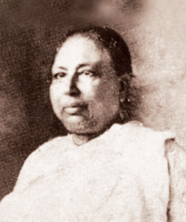Haimabati Sen (1866 – 5 August 1933)[1] born Haimabati Ghosh, was an Indian physician.
Haimabati Sen | |
|---|---|
 | |
| Born | Haimabati Ghosh 1866 Kulna district, Bengal Presidency, British India |
| Died | 5 August 1933 |
| Other names | Haimabati Ghosh Mitra Sen |
| Occupation | Physician |
| Spouse | Kunjabihari Sen (m.1890) |
Early life
editHaimabati Ghosh was born in the Khulna district, Bengal Presidency (now Bangladesh). Her father was a zamindar, a wealthy member of the Kulin Kayastha caste.[2] As a very young widow, she trained as a teacher in Benares. After her second marriage, she attended the Campbell Medical College in Calcutta,[3][4] and graduated at the top of her class in 1894.[5]
Career
editSen was a physician at the Lady Dufferin Women's Hospital in Hooghly from 1894 to 1910,[3][6] and had a private practice in Chinsurah, until her death in the early 1930s.[5] She wrote a "valuable"[2] memoir in the 1920s, detailing her own struggles and her concerns for all young women: "Do I have to suffer all this simply because I am a woman? Would anyone have inflicted so much suffering on a man? Why are they so worried as to whose wife I am or whose daughter?"[2] Her memoir was translated from Bengali and published in English many years later, in 2000.[7]
Personal life
editHaimabati Ghosh married twice. She was first married at age 9, to a widower with two daughters; a year later, she was a child widow. Without the support of her husband, parents, brothers, or in-laws, she sought assistance at a widows' house in Benares, and joined the Brahmo Samaj community.[citation needed] In 1890, she married again, to Kunjabehari Sen. They had five children together. Haimabati Sen died in 1932 (or 1933),[8] in her sixties.[5]
References
edit- ^ Subodh Kumar Sengupta & Anjali Bose (2016). Sansad Bengali Charitabhidhan Vol.I. Sahitya Sansad,Kolkata. p. 883. ISBN 978-81-7955-135-6.
- ^ a b c Sen, Indrani (2012). "Resisting Patriarchy: Complexities and Conflicts in the Memoir of Haimabati Sen". Economic and Political Weekly. 47 (12): 55–62, quotes from pages 55 and 57. ISSN 0012-9976. JSTOR 23214502.
- ^ a b Forbes, Geraldine Hancock (2005). Women in Colonial India: Essays on Politics, Medicine, and Historiography. Orient Blackswan. p. 146. ISBN 978-81-8028-017-7.
- ^ Mukherjee, Sujata (5 January 2017). Gender, Medicine, and Society in Colonial India: Women's Health Care in Nineteenth- and Early Twentieth-Century Bengal. Oxford University Press. doi:10.1093/acprof:oso/9780199468225.001.0001. ISBN 978-0-19-946822-5.
- ^ a b c Chattopadhyay, Anjana (2018). Women Scientists in India: Lives, Struggles & Achievements (PDF). National Book Trust, India. ISBN 978-81-237-8144-0.
- ^ "Book on India's premier women doctors". The Hans India. 17 October 2019. Retrieved 19 October 2020.
- ^ Sen, Haimabati (2000). The Memoirs of Dr. Haimabati Sen: From Child Widow to Lady Doctor. Roli Books. ISBN 978-81-7436-090-8.
- ^ "Haimabati Ghosh Mitra Sen". Oxford Reference. Retrieved 19 October 2020.